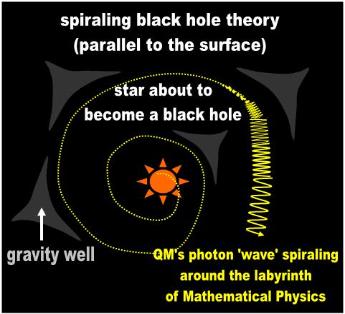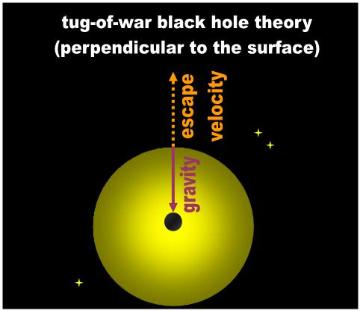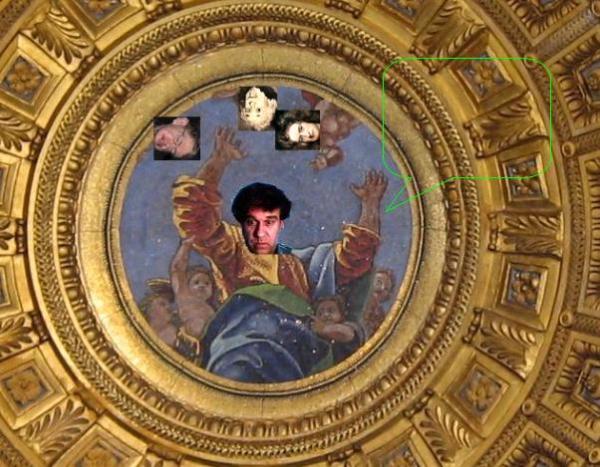| Adapted for the Internet from: Why God Doesn't Exist |
| How black holes form: escape velocity versus spiraling photons |
1.0 Relativists have inconsistent explanations for why light cannot escape a black hole
The mathematicians who call themselves physicists tell us that black holes follow logically from their
equations, and form through the infamous escape velocity analogy. Take pigeon poop and throw it at the
Moon. You will verify that the Moon laughs in your face. Why? Because gravity pulled the poop back to Earth
and dropped it on your head. In order for you to hit the Moon you will need to throw the poop at a speed
greater than the escape velocity of Earth. That’s the speed space shuttles have to pick up if they want to go
into orbit. Now extrapolate this scenario to a star that is millions of times larger and gravitationally stronger
than the Earth. If you wanted to throw a stone from its surface and place it in orbit you would need a lot more
muscle to overcome its escape velocity. I guess that by now you are getting the hang of things. You can
imagine a star so huge that you would need to travel at the speed of light to exceed its escape velocity. But
whereas stars can be as big as your imagination, the maximum speed limit of light is imposed by Ol’ Man
Universe. These two features combine for fascinating ‘physics.’
So what happens if you imagine a star that has an escape velocity equal to the speed of light?
I guess this means that the photon is paralyzed right there at the surface of the sphere (i.e., the event horizon).
The photon is tugged at equal speeds from both directions. It can neither go forward nor backward. Light no
longer travels at little c. Now it is just standing still. If relativists have their way, a black hole that has its escape
velocity exactly equal to little c is a fence made of static photons:
- “ the rays of light that form the event horizon” (p. 100) [1]
“ A non-rotating black hole’s photon sphere is a spherical boundary of zero
thickness” [2]
The event horizon is an inexistent fence that encloses absolutely nothing. The width of this boundary is made
of photons, but is conveniently zero-thick. I guess this finally confirms it. Photons not only have no mass. Now
they also have no structure. A photon is absolutely nothing. The mathematicians go out of their way to cover
all the bases to ensure that you cannot challenge any part of their religion.
Why would an astronaut want to cross this non-entity known as the event horizon ? What does he expect to
find on the other side? I also wonder how bright these suspended photons are. (Or the theorists who came up
with this nonsense, for that matter!)
But my imagination is too modest for the mathematicians. What if we make the star ‘infinitely’ big? Under these
conditions, I guess that we should expect the photon to travel faster than light in the opposite direction.
- “ We can imagine that for a sufficiently massive and concentrated body, the escape
velocity could exceed even the velocity of light! When this happens, we have a
black hole.” (p. 332) [3]
[ A photon being dragged to the singularity faster than a photon? Man, that’s deep!
I thought only Superman and Flash could exceed little c! And this guy is a university
professor somewhere in Merrie Olde England!]
The mathematicians assert that by this time all the matter that made up the star has disintegrated, so the photon
encounters no resistance on its way to the center of… Of what?
- “ As to what lies in the region between a singularity and its event horizon, physicists
have always drawn a blank, literally. No matter what type of material formed the
singularity, the area inside the event horizon was supposed to be devoid of any
structure or measurable characteristics.” [4]
- So let’s see… We have the center of mass of nothing pulling on the sides of a mass-less particle at a speed
greater than relativity allows. This 0-D entity travels through nothing. So what do we have?
So far, after violating every possible definition and amending all their relevant assumptions, it appears that the
mathematicians have nothing, absolutely nothing at all:
- “ Not a pinhead size, or any size, but a literal point, zero wide, zero high, zero deep.
We cannot imagine such a thing, but physics says that is what happens, and that
is a black hole, matter that is so dense it is no longer ‘matter’ in any real sense, but
some kind of singularity (or anomaly) in space.” [5]
- The event horizon is the only abstract enclosure God in his clumsy ways created to enclose absolutely nothing.
The mathematicians get away with such nonsense by brushing aside inalienable ‘principles’ and definitions. In
one presentation they say that matter is ‘that which has mass’ and that no object can travel faster than a photon.
In the next presentation, they explain that ‘matter-less’ mass has the ability to gobble up astronauts at speeds
faster than light. On the one hand, they claim that a black hole can have any ‘size’, and one foolishly believes
that these idiots are referring to what everyone and his mother understands by size: how big something is or
how much volume something occupies. It turns out that the morons are talking about mass:
- “ Sizes of black holes… Black holes can be of almost any mass… Black holes can
be divided into several size categories:… Intermediate-mass black holes, whose
size is measured in thousands of solar masses…” [6]
- Now what does mass have to do with size? How tall is a 1000 ton building?
It is not so much the supernatural Alice-in-Wonderland world that relativists and mechanics illustrate that is
troubling. It is the mathematicians’ inconsistent use of ‘laws’ and definitions that makes you wonder about their
state of mind and understanding. The great problem with Mathematical Physics is its unscientific language.
2.0 Escape velocity versus spiraling photons
But let’s return to the subject at hand, which is how black holes are allegedly created. Penrose and Parker fall
back on the escape velocity analogy to explain the formation of a black hole. They have the photon shooting
straight up from the surface. As gravity increases, there comes a moment when the photon can’t pick up
enough speed to escape the event horizon:
- “ As a body is crushed into a smaller and smaller volume, the gravitational attraction
increases, and hence the escape velocity gets bigger. Things have to be thrown
harder and harder to escape. Eventually a point is reached when even light, which
travels at 186 thousand miles a second, is not travelling fast enough to escape…
you can see that photons emitted at late times stop moving outwards and return
back towards the axis. This is the moment at which the black hole forms.” [7]
- This is the Quantum or 'force' version of black hole formation and is perhaps the most popular. However,
Lochner does it a little differently. He relies on the General Relativity or gravity well version of black hole
formation. The reason a photon doesn’t reach us has nothing to do with escape velocity. It doesn’t reach
us because the poor fella is trapped in a space that is curved like a shell around the now defunct star.
Lochner has the photon perpetually orbiting warped space:
“ As the density increases, the path of light rays emitted from the star are bent and
eventually wrapped irrevocably around the star. Any emitted photons are trapped
into an orbit by the intense gravitational field; they will never leave it.” [8]
“ as the mass inside the given region of space increases, its gravity becomes stronger
and (in the language of relativity) increasingly deforms the space around it” [9]
- Parker’s photon shoots straight out perpendicular to the surface of the sphere and are drawn straight
down towards the singularity (Fig. 1 A). Lochner’s photon never makes it to the singularity. It orbits
perpetually around the warped space that surrounds a star (Fig. 1 B). That's why relativists claim it has no
chance of reaching your eyes. Parker has gravity tugging at a particle or wave (force), despite that relativity
outlawed the word force! Lochner has warped space perpetually deflecting the path of a particle or wave.
As always, the mathematicians want the best of all worlds and make their theories hermetically un-falsifiable.
- Module main page: Why black holes don't exist
Pages in this module:
- 1. How can a black hole exist if it is an abstract concept?
2. What is the hole into?
3. This page: How black holes form: escape velocity vs. spiraling photons?
4. A black hole behaves inconsistently
5. Is there proof of the existence of black holes?
6. Since they couldn't explain it with black holes, they invented dark matter
Fig. 1 Escape velocity versus spiraling black hole theories [Spiraling photons? Bartender! I’ll have whatever he had!] |
A
B



| No, fellas! Don't! Not into the singularity! Please! |
| Relativity holds that gravity wells should extend in every direction around a celestial object. This is impossible to imagine because it means that a star should be surrounded radially by gravity wells. The hard part is distinguishing one groundhog’s hole from its neighbor’s. Isn’t the entire spherical cornfield supposed to be a single gofer hole? But let’s overlook this shortcoming momentarily and see where it leads. I have illustrated four gravity wells (A) surrounding a massive star about to become a black hole. The mathematicians claim that a photon spirals around warped space, constrained by these gravity wells. This explanation is irreconcilable with the escape velocity analogy (B) where the photon is pulled directly from the surface along an axis leading towards the center of the star. In the spiraling scenario, the black hole does not affect the photon. The black hole bends space and the poor photon is condemned to roll around the roulette forever. In the case of escape velocity, the singularity tugs directly on the photon. Indeed, under the escape velocity 'force' version of black hole formation, any speed of gravity less than c should have no effect on the photon. A speed equal to c should stop it in its tracks. And any speed greater than c should instantly pull it straight towards the center like you are being pulled at this moment towards the center of Earth. In the spiraling scenario, the photon escapes the event horizon and just gets a life sentence in a prison known as warped space. generates bend a continuous wave or deflect the itinerary of a discrete particle. Are we talking springs or marbles? |
- ________________________________________________________________________________________
- Copyright © by Nila Gaede 2008
